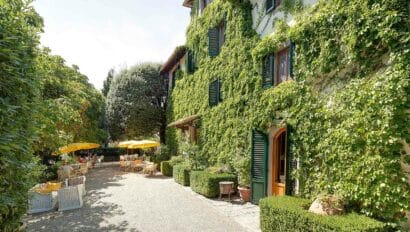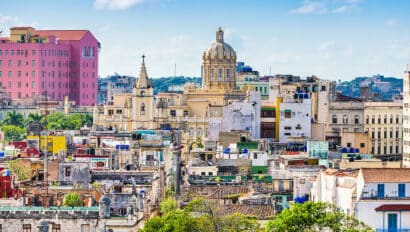A stroll through an ancient garden relaxes the soul and nourishes the senses.
We love a good walking vacation. It’s the best way to immerse yourself into the life and culture of a new destination. It’s also the best way to experience a beautiful garden — and we’ve seen many a beautiful garden. Here are four of our favorite garden walking tours:
Villa Rufolo, Ravello, Italy
Overlooking Piazza Vescovado and with magnificent views to the Bay of Salerno, Villa Rufolo is the cultural and historical center of Ravello. Built by a wealthy merchant in the 13th century, the villa has been memorialized in literary works such as “Decameron,” by Italian renaissance author, Boccaccio. It’s storied past includes banquets for King Robert II of Naples and other Norman royalty and legends of hidden treasures.
In 1851, Sir Francis Neville Reid, a Scottish botanist, fell in love with the property despite its state of disrepair and neglect at the time. He purchased the estate and began an extensive renovation on the property including the gardens.
Know as the “Garden of the Soul,” the garden of Villa Rufolo is bi-level with ancient walls nearly hidden by cypress and lime trees. Reid stocked the garden with a variety of exotic plant species, which remain today. One such species is the Mediterranean cypress or pencil pine, which appears to originate from the eastern shores of the Mediterranean. It was originally imported by the Phoenicians for its highly ornamental pyramidal form.
Another beautiful plant in the gardens is the creeping or climbing fig. It originates in south-eastern Asia, is a vigorous climber with small, dark green heart-shaped leaves. Its aerial roots adhere to walls.
The large-leaved lime or linden, is a deciduous tree with heart-shaped leaves with serrated edges. They produce fragrant whitish-yellow flowers in May and June, arranged in drooping clusters of two or more hermaphrodite flowers.
Today, the magical gardens and villa grounds are open to the public year-round.
Gardens of Château de Marquessac, Dordogne region, France
Step into the otherworldly landscape of the Gardens of Château de Marquessac, designed by a student of André Le Notre, the famous designer behind the gardens of the Château de Versailles. The formal French-style garden is up-ended — almost becomes a playful version of itself — with dramatic swirls and rounds. The garden is comprised of rosemary, santoline and 150,000 pruned box trees.
Once you recover from the wonder of this sight, you’ll notice the garden’s prominent cliff-side position overlooking the Dordogne River. You’ll see four of the famed castles of the area, including Castelnaud, Beynac and Fayrac.
Botanical Garden, Cienfuegos, Cuba
An 1899 meeting between an American sugar planter in Cuba and two Harvard professors established The Harvard Botanic Station for Tropical Research and Sugar Cane Investigation in Cienfuegos, Cuba.
In 1920, the ties between the garden and Harvard became more formal with a large endowment provided by the sugar cane farmer and the recognition of the garden as part of the university. Harvard Biological Laboratory was constructed at the garden four years later.
During the 1930s, the garden reached its peak of beauty and diversity as a tropical arboretum. It was used by professors, students and visiting fellows to study tropical botany. Local citizens made up the grounds crew. With the Cuban revolution in 1959 and later the U.S. embargo American involvement was restricted and Harvard terminated its support. Today garden is run by the Cuban government and is both a National Monument and a popular tourist destination.
More than 2,000 species of plants thrive in this amazing 230-acre expanse in the gently rolling countryside just outside Cienfuegos. It’s the only plot on earth where you can see 280 kinds of palms in a single setting. It’s also a marvelous place to spot hummingbirds, trogons and other birds.
Annapolis Royal’s Historic Gardens, Annapolis Royal, Nova Scotia
This 17-acre paradise, overlooking a tidal river valley, marks the first European settlement in North America. It’s divided into themed areas that tell the story of the area’s local history from a horticultural perspective of gardening methods and designs.
La Maison acadienne design is based on diary notes from the Acadian era and includes an orchard and willow hedge. It includes the only archeologically authenticated replica of a pre-deportation Acadian dwelling in the Maritime region — a 1671 time period when Port-Royal (later Annapolis Royal) was the center of Acadie.
Herbs, flowers and heritage 18th-century apple trees fill the Governor’s Garden. They are arranged according to the traditions of the mif-1700s period, when Annapolis Royal was the capital of Nova Scotia, then under British rule.
Other gardens include more than 3000 brightly colored annuals; hydrangea and day lilies; a rock garden; a heather bed and a rose garden with more than 270 cultivars.




